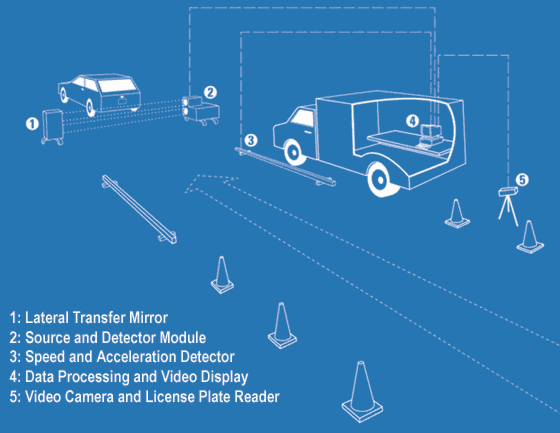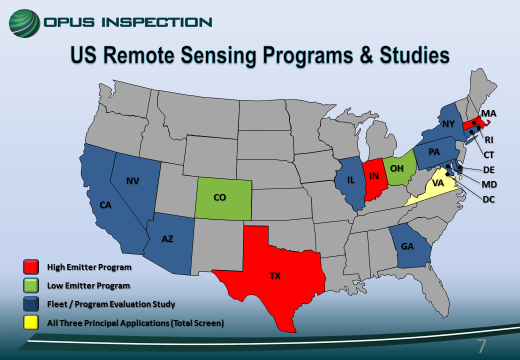What is remote sensing?
+
Remote sensing measures real driving emissions as vehicles drive by in normal everyday driving conditions, using emission analyzers specially adapted for roadside use. Opus remote sensing technology captures pollutant levels, license plates, speed, and acceleration to form a complete test record. Remote sensing devices (RSDs) can collect thousands of measurements a day and can be quickly and easily moved between locations for cost-effective emission monitoring.
What does remote sensing measure?
+
Concentrations of Carbon Monoxide (CO), Hydrocarbons (HC), Oxides and Dioxides of Nitrogen (NO and NO2) and particulate matter (PM). The sensors detect emissions from tailpipe exhausts, as well as evaporative emissions caused by leaks from fuel lines, pumps, tanks, and other components.
How does it work?
+
Remote sensing measurements are typically made as vehicles accelerate onto a highway, under moderate engine load and at moderate speed. The system shines beams of ultraviolet and infrared light across the road. The amount of specific wavelengths of light absorbed by the pollutant in the vehicle's exhaust and evaporative emissions is recorded and those readings enable us to determine the concentrations of pollutants present.

How is it used?
+
Opus provides remote sensing services in the US and Europe for a variety of purposes, including:
- Low emission (Clean Screen) testing: Drivers can choose to complete their inspection by having their emission measured as they drive by. Vehicles passed as clean are exempted from their next station-based periodic inspection.
- High emitting tests: Vehicles identified with very high emissions are notified that they must report for re-inspection.
- Evaluating emission testing programs: For example, by comparing an emissions snapshot of the vehicle fleet at the start of a program and after some time has passed to determine if overall fleet emissions have reduced.
- Other applications: Such as surveilling particular vehicle makes and models for defeat mechanisms, or identifying fraudulent station inspections by measuring the vehicles on the road soon after test.

How effective is Opus remote sensing?
+
Our programs have collected more than 150 million valid inspection records since the 1990s. We have identified more than 3.5 million clean vehicles that earned exemptions from their next periodic emission inspection and notified more than 30,000 high emitters of the need to return for reinspection. We have also evaluated entire vehicle fleets and inspection programs and surveilled certified vehicle models to detect manufacturer defeat devices.
How is Opus remote sensing verified?
+
Opus remote sensing services have met all industry performance standards for devices and applications since the mid-1990s. Our RSDs have consistently passed US standards, including the California Bureau of Automotive Repair (BAR) industry performance specification, On-Road Emission Measurement System (OREMS), and the Colorado On-road Vehicle Emission Remote Sensing (COVERS) specification, which has been recognized as the industry standard since the mid-2000s.
- Device accuracy/dry gas certifications: Opus RSDs have achieved greater than 98% accuracy in rigorous real-world tests performed by the Colorado Department of Public Health and Environment (CDPHE).
- Comparison to other analyzers: Authorities in Asia, North America, and Europe have compared Opus RSDs to other trusted emission analyzers, with excellent results.
- Screening accuracy (accurate screening of individual vehicles or monitoring of vehicle fleets): In an independent trial by BAR, high-emitting vehicles screened by two RSDs were verified as high with at least 92% accuracy in immediate pullover roadside dynamometer tests.
- Accuracy compared to periodic inspections: Data from Colorado, where Opus operates both periodic inspection and remote sensing Clean Screen testing, show the same high level of emission testing accuracy across a range of gases and vehicle model years.
How can remote sensing add value to an existing emission testing program?
+
Remote sensing collects large quantities of on-road vehicle emission measurements, providing a large database of information that can be mined to:
- Exempt low-emitters (saving motorists time and money by avoiding a station inspection, and focusing the remaining stations on inspecting the higher emitting vehicles);
- Reinspect high emitters early;
- Assess the aggregate impact of the program;
- Deter tampering; and
- Surveil inspection stations, vehicle manufacturers and aftermarket control manufacturers.
Remote sensing can also be used in tandem with portable emission measuring systems (PEMS), a mobile testing system designed to perform detailed tests on individual polluting vehicles. Remote sensing is used to screen highly polluting vehicle years, makes, and model groups, which can then be verified with PEMS. The combination of Remote Sensing and PEMS provides a complete mobile solution for surveillance, enforcement and compliance.
Find out more about how remote sensing applications can complement an emission testing program


